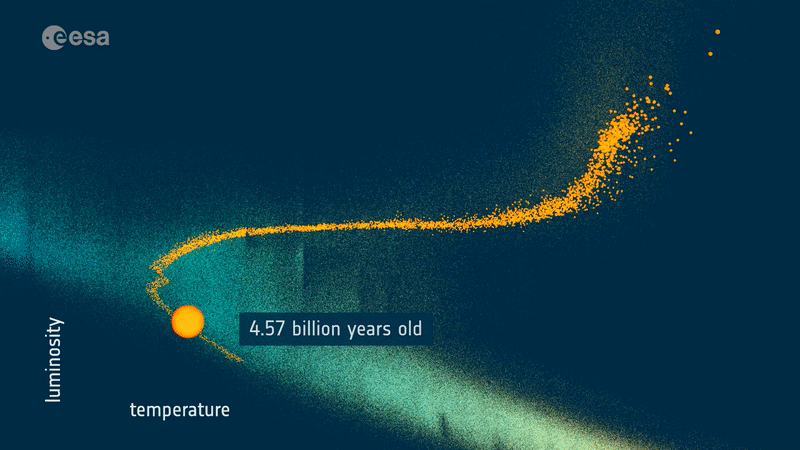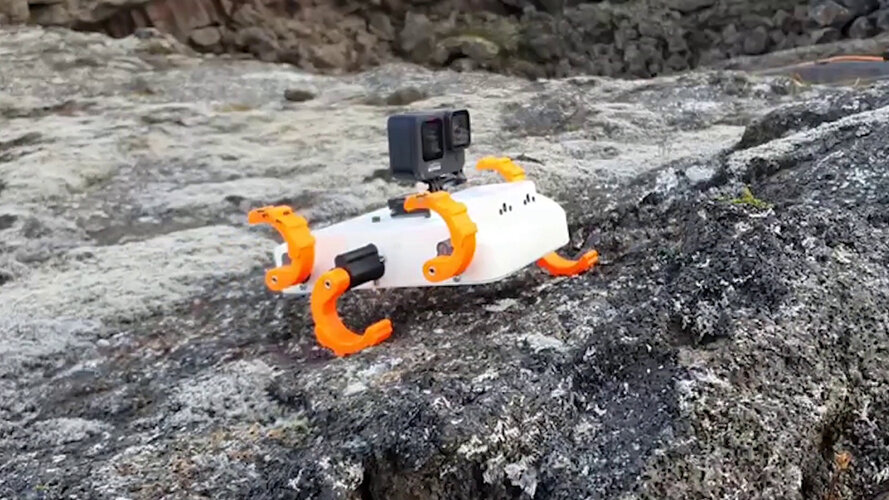
Copernical Team
Gaia reveals the past and future of the Sun

We all wish that we could sometimes see into the future. Now, thanks to the very latest data from ESA’s star mapping Gaia mission, astronomers can do just that for the Sun. By accurately identifying stars of similar mass and composition, they can see how our Sun is going to evolve in the future. And this work extends far beyond a little astrophysical clairvoyance.
Lunar Zebro
 Video:
00:06:52
Video:
00:06:52
Lunar Zebro, a project of the Delft University of Technology in the Netherlands wants to build a robot and be the first Dutch and European rover to walk on the Moon. Their lunar rover does not only distinguish itself by its small size taking up the same area as an A4 sheet of paper, but also by its unique locomotion. Driven by C-shaped legs instead of wheels, the six-legged rover from where it takes its name in Dutch “zes-benige robot”, will be able to climb over much taller obstacles than its wheeled counterparts, making it ideal for
NanoAvionics extends its satellite bus range enabling advanced space missions
 Global mission integrator NanoAvionics has added two microsatellite buses, the MP42H and the MP42D, to its product line based on its flagship MP42 bus. Capable to host customer payloads of up to 145 kg and a total satellite mass of up to 220 kg, the company has now one of the widest ranges of commercially available modular microsatellite buses in the industry.
Designed to significantly red
Global mission integrator NanoAvionics has added two microsatellite buses, the MP42H and the MP42D, to its product line based on its flagship MP42 bus. Capable to host customer payloads of up to 145 kg and a total satellite mass of up to 220 kg, the company has now one of the widest ranges of commercially available modular microsatellite buses in the industry.
Designed to significantly red Fermi confirms star wreck as source of extreme cosmic particles
 Astronomers have long sought the launch sites for some of the highest-energy protons in our galaxy. Now a study using 12 years of data from NASA's Fermi Gamma-ray Space Telescope confirms that one supernova remnant is just such a place.
Fermi has shown that the shock waves of exploded stars boost particles to speeds comparable to that of light. Called cosmic rays, these particles mostly ta
Astronomers have long sought the launch sites for some of the highest-energy protons in our galaxy. Now a study using 12 years of data from NASA's Fermi Gamma-ray Space Telescope confirms that one supernova remnant is just such a place.
Fermi has shown that the shock waves of exploded stars boost particles to speeds comparable to that of light. Called cosmic rays, these particles mostly ta First stars and black holes
 Just milliseconds after the universe's Big Bang, chaos reigned. Atomic nuclei fused and broke apart in hot, frenzied motion. Incredibly strong pressure waves built up and squeezed matter so tightly together that black holes formed, which astrophysicists call primordial black holes.
Did primordial black holes help or hinder formation of the universe's first stars, eventually born about 100
Just milliseconds after the universe's Big Bang, chaos reigned. Atomic nuclei fused and broke apart in hot, frenzied motion. Incredibly strong pressure waves built up and squeezed matter so tightly together that black holes formed, which astrophysicists call primordial black holes.
Did primordial black holes help or hinder formation of the universe's first stars, eventually born about 100 UK scientists have created an 'eternal engine' to keep the next generation of atomic clock ticking.
 Atomic clock precision timing is essential for systems such as global navigation, satellite mapping, establishing the composition of exoplanets and the next generations of telecommunication. But atomic clocks are currently massive devices - weighing hundreds of kilograms - which need to be housed within precise, difficult-to-maintain conditions. That's why scientists around the world are racing
Atomic clock precision timing is essential for systems such as global navigation, satellite mapping, establishing the composition of exoplanets and the next generations of telecommunication. But atomic clocks are currently massive devices - weighing hundreds of kilograms - which need to be housed within precise, difficult-to-maintain conditions. That's why scientists around the world are racing Study finds evidence that giant meteorite impacts created the continents
 New Curtin research has provided the strongest evidence yet that Earth's continents were formed by giant meteorite impacts that were particularly prevalent during the first billion years or so of our planet's four-and-a-half-billion year history.
Dr Tim Johnson, from Curtin's School of Earth and Planetary Sciences, said the idea that the continents originally formed at sites of giant meteo
New Curtin research has provided the strongest evidence yet that Earth's continents were formed by giant meteorite impacts that were particularly prevalent during the first billion years or so of our planet's four-and-a-half-billion year history.
Dr Tim Johnson, from Curtin's School of Earth and Planetary Sciences, said the idea that the continents originally formed at sites of giant meteo Progressing through the pass: Sols 3560-3561
 Curiosity is continuing to press on through Paraitepuy Pass with the successful completion of last plan's drive and another coming up on the first sol of today's two-sol plan.
The terrain continues to be tricky, with lots of sand and rocks, as you can see in the Hazcam image, and the rover planners are working hard to determine the best and safest way forward. In between carefully creeping
Curiosity is continuing to press on through Paraitepuy Pass with the successful completion of last plan's drive and another coming up on the first sol of today's two-sol plan.
The terrain continues to be tricky, with lots of sand and rocks, as you can see in the Hazcam image, and the rover planners are working hard to determine the best and safest way forward. In between carefully creeping Helga and Zohar are ready for their flight around the Moon
 Three mannequins, a beagle and a sheep fly around the Moon in a giant rocket ... extraordinary, isn't it? This special crew is part of NASA's Artemis I mission, scheduled to launch from Kennedy Space Center in Florida on 29 August 2022.
On board are three mannequins, Helga and Zohar, two identical model females from the German Aerospace Center (Deutsches Zentrum fur Luft- und Raumfahrt; DL
Three mannequins, a beagle and a sheep fly around the Moon in a giant rocket ... extraordinary, isn't it? This special crew is part of NASA's Artemis I mission, scheduled to launch from Kennedy Space Center in Florida on 29 August 2022.
On board are three mannequins, Helga and Zohar, two identical model females from the German Aerospace Center (Deutsches Zentrum fur Luft- und Raumfahrt; DL Northrop Grumman invests in new solid rocket motor manufacturing facilities in Magna, Utah
 Northrop Grumman Corporation (NYSE: NOC) is expanding its solid rocket motor manufacturing facilities with the groundbreaking of new state-of-the art facilities to support nearly every phase of solid rocket motor manufacturing, including case manufacturing, propellant mixing and casting, and final assembly.
The infrastructure investment and expansion of solid rocket motor manufacturing wil
Northrop Grumman Corporation (NYSE: NOC) is expanding its solid rocket motor manufacturing facilities with the groundbreaking of new state-of-the art facilities to support nearly every phase of solid rocket motor manufacturing, including case manufacturing, propellant mixing and casting, and final assembly.
The infrastructure investment and expansion of solid rocket motor manufacturing wil 
